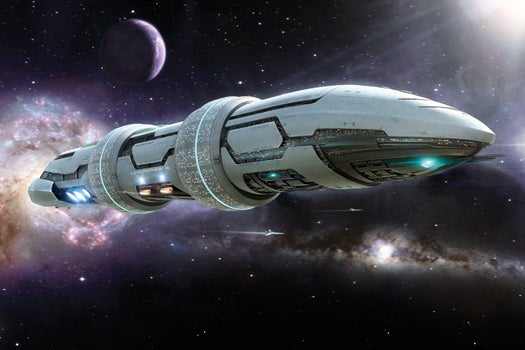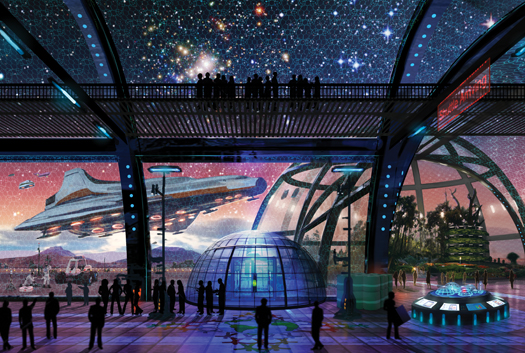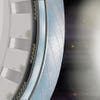After Earth: Why, Where, How, and When We Might Leave Our Home Planet
Humanity may have millennia to find a new home in the universe--or just a few years

Earth won’t always be fit for occupation. We know that in two billion years or so, an expanding sun will boil away our oceans, leaving our home in the universe uninhabitable—unless, that is, we haven’t already been wiped out by the Andromeda galaxy, which is on a multibillion-year collision course with our Milky Way. Moreover, at least a third of the thousand mile-wide asteroids that hurtle across our orbital path will eventually crash into us, at a rate of about one every 300,000 years.
Why?
Indeed, in 1989 a far smaller asteroid, the impact of which would still have been equivalent in force to 1,000 nuclear bombs, crossed our orbit just six hours after Earth had passed. A recent report by the Lifeboat Foundation, whose hundreds of researchers track a dozen different existential risks to humanity, likens that one-in-300,000 chance of a catastrophic strike to a game of Russian roulette: “If we keep pulling the trigger long enough we’ll blow our head off, and there’s no guarantee it won’t be the next pull.”
Given the risks humans pose to the planet, we might someday leave Earth simply to conserve it.Many of the threats that might lead us to consider off-Earth living arrangements are actually man-made, and not necessarily in the distant future. The amount we consume each year already far outstrips what our planet can sustain, and the World Wildlife Fund estimates that by 2030 we will be consuming two planets’ worth of natural resources annually. The Center for Research on the Epidemiology of Disasters, an international humanitarian organization, reports that the onslaught of droughts, earthquakes, epic rains and floods over the past decade is triple the number from the 1980s and nearly 54 times that of 1901, when this data was first collected. Some scenarios have climate change leading to severe water shortages, the submersion of coastal areas, and widespread famine. Additionally, the world could end by way of deadly pathogen, nuclear war or, as the Lifeboat Foundation warns, the “misuse of increasingly powerful technologies.” Given the risks humans pose to the planet, we might also someday leave Earth simply to conserve it, with our planet becoming a kind of nature sanctuary that we visit now and again, as we might Yosemite.
None of the threats we face are especially far-fetched. Climate change is already a major factor in human affairs, for instance, and our planet has undergone at least one previous mass extinction as a result of asteroid impact. “The dinosaurs died out because they were too stupid to build an adequate spacefaring civilization,” says Tihamer Toth-Fejel, a research engineer at the Advanced Information Systems division of defense contractor General Dynamics and one of 85 members of the Lifeboat Foundation’s space-settlement board. “So far, the difference between us and them is barely measurable.” The Alliance to Rescue Civilization, a project started by New York University chemist Robert Shapiro, contends that the inevitability of any of several cataclysmic events means that we must prepare a copy of our civilization and move it into outer space and out of harm’s way—a backup of our cultural achievements and traditions. In 2005, then–NASA administrator Michael Griffin described the aims of the national space program in similar terms. “If we humans want to survive for hundreds of thousands or millions of years, we must ultimately populate other planets,” he said. “One day, I don’t know when that day is, but there will be more human beings who live off the Earth than on it.”

Near Earth
Where?
We have many options. The National Space Society, whose more than 12,000 members are committed to establishing settlements in space, suggests that we’ll probably first go to a planet that has the resources to support life. After completing a $200-million study in 2000, NASA reported that a colony could be dug several feet beneath our own moon’s surface or covered within an existing crater to protect residents from the constant bombardment of high-energy cosmic radiation, which can damage our DNA and lead to cancer. The NASA study envisions an onsite nuclear power plant, solar panel arrays, and various methods for extracting carbon, silicon, aluminum and other useful materials from the lunar surface. The National Space Society, in its own 2008 report “Roadmap to Space Settlement,” also identifies the moon as the logical initial stop, citing the presence of life-sustaining ice there as a precursor to permanent lunar bases, hotels and even casinos.
Other space-settlement advocates suggest skipping the moon entirely. Although our moon is closer and we’ve already landed people there, the moons of Jupiter, Saturn, Uranus and Neptune are believed to contain variously greater quantities of water, carbon or nitrogen. But the most Earth-like of the destinations in our solar system is Mars. “Mars compares to the moon as North America compared to Greenland in the previous age of maritime exploration,” says Robert Zubrin, the head of the Mars Society, a group pushing for expeditions to and settlement of the Red Planet. Unlike the moon, Mars has a bit of an atmosphere, which would offer some protection from cosmic rays, and about 40 percent of Earth’s gravity.
In 2002, NASA’s Mars Odyssey spacecraft detected continent-size regions of water ice in the Martian ground, and in 2008, photographs from the Phoenix Mars lander confirmed the presence of ice there. Enough carbon also resides in the soil to grow plants, and the daytime temperatures occasionally reach a balmy 70°F. It’s plausible, too, that over time the planet could be “terraformed,” using water from underground ice (or importing it from an ice asteroid) to form a thin ocean and, much later, to create an atmosphere offering breathable air and a better shield against cosmic radiation. “It’s much easier to settle a planet than to build one,” Zubrin says. “Christopher Columbus sailed across the ocean in a boat. Imagine if he’d had to build the American continent once he got there.”
Click to launch our ideas for surviving the multigenerational journey to our new home.
All of these suggested routes, however, may fall under the category of what Isaac Asimov once called “planetary chauvinism.” We could just as well build an orbital habitat, erecting our future home in the void and engineering each of its details to our own exacting specifications. Financially, if not technologically, it is impossible to launch the amount of materials from Earth that one would need to build a large orbiting structure. But such a habitat could be constructed primarily of resources extracted from near-Earth asteroids, which in themselves provide more terrestrial variety and potential surface area than all the planets in our solar system put together. In 1974, Princeton University physicist Gerard O’Neill presented a design of a massive freestanding orbital habitat consisting of large cylinders spinning along an axis at a rate of about one rotation per minute—just fast enough to simulate gravity along its inner surfaces—and linked to another cylinder spinning in the opposite direction to eliminate torque. In gravity-free outer space, the habitats could remain structurally sound even at sizes large enough to house thousands, or millions, of residents, and O’Neill imagined twin cylinders 20 miles in length and with an interior surface area of 500 square miles.
Al Globus, a contractor at NASA’s Ames Research Center who maintains a well-regarded space-settlement website, speaks of the O’Neill Cylinder as one would a tony gated community, a place with constant sunlight, tremendous views, spacious quarters, and dedicated areas near the axes of the cylinders for zero-G recreation. Populations on these ships would be kept well above 150 people to avoid the consequences of inbreeding, although ideally the rotating habitats would exist in socially interactive clusters. Residents could also use stored DNA whenever the gene pool needed more variety.
A primary advantage of an orbital habitat is that it would not necessarily need to stay in orbit. If a ship exhausted the resources of a nearby asteroid or had to escape a dying sun, it could be rigged up with an onboard nuclear reactor or a solar sail and sent out to any number of faraway destinations. None of the 500 planets known to orbit stars outside our solar system is believed to have an atmosphere capable of sustaining human life, but almost all of these were discovered in the past decade, leading two astronomers to conclude in a recent paper that the probability of finding an exoplanet with a habitat nearly identical to that of the Earth’s by 2264 is 95 percent. In September, a group of astronomers with the Lick-Carnegie Extrasolar Planet Survey, sponsored by NASA and the National Science Foundation, announced the discovery of a planet about 20 light-years away, in the constellation Libra, that orbits its star well within the “habitable zone” of our own orbit.
For successive generations living aboard an enclosed ship, it may not even matter if they remain in Earth’s orbit or travel for hundreds of years toward one of these extrasolar planets. They may simply float through space in their “generation ship,” harvesting materials from asteroids and comets along the way.

New World
How?
The first challenge is simply to escape the pull of Earth’s own gravity. “If you can get your ship into orbit, you’re halfway to anywhere,” the writer Robert Heinlein said. The space shuttle flew at around $450 million a trip, and today sending unmanned payloads into orbit will still set you back about $12,000 a pound, with much of the cost coming from the fuel burned in those first hundred miles.
To clear this imposing initial hurdle, engineers have dreamed up many rocketless launch systems. At the height of the Cold War, the U.S. Navy, as part of its High Altitude Research Program, investigated the feasibility of using a giant cannon to blast payloads into orbit. Physicist Derek Tidman, meanwhile, envisions using a massive centrifuge, which he calls a “slingatron,” to spin objects until they reach a velocity at which they can be flung out of our gravitational well. And many engineers have contemplated the enticing possibility of constructing a “space elevator” that rides up a 62,000-mile-long cable held aloft, like a spinning lasso, by centripetal force. In 2000, NASA’s Institute for Advanced Concepts gave Brad Edwards, founder of the company Carbon Designs, $570,000 to investigate how to construct such a device, and he estimates that he could build one for no more than $14 billion—once someone develops the nanotechnology necessary to fabricate the very thin, very strong tubes that would make up the line.
Other innovations might reduce payload weights enough to render spaceflight more practical. A company called Made in Space says its proposed giant 3-D printers could transform feedstock shipped from Earth or recycled from space junk into satellites or ships, although how the printers will fare in zero gravity has yet to be seen. Further nanotech breakthroughs could also help. J. Storrs Hall, an independent scientist and author who specializes in molecular nanotechnology, cites as an example the tremendous amount of copper we use for conductivity and electrical wiring. By controlling matter at the molecular scale, graphene conductors could be created from pure carbon, as could transistors and even computers.
Colonizing space “isn’t just about survival, it’s about thriving.”Once we get beyond low Earth orbit, we might also figure out how to travel epic distances using something other than chemical rockets. Last November, Popular Science profiled Franklin Chang Díaz, a former NASA astronaut who is developing a rocket powered by an onboard ion engine, which, he estimates, could cut travel time to Mars from six months to a little more than one. A Japanese probe propelled by a 46-foot-wide solar sail, composed of aluminized plastic 0.0075 millimeters thick and pushed along by the pressure of the sun’s photons, flew past Venus in December. The Japan Aerospace Exploration Agency says the probe is now circling the sun and will return to enter Venus’s orbit in another five years. If we’re able to devise some form of fusion drive, many believe we might be able to fuel it with helium-3 mined from the moon or other celestial bodies. And NASA’s Institute for Advanced Concepts is funding a study to see whether spaceships might be able to hitch a ride with one of the 40 asteroids that periodically pass by both our planet and Mars, the ship traveling energy-free as it reaches its destination in six to 10 months.
Marc Millis, a NASA propulsion physicist who also runs the Tau Zero Foundation, a volunteer group of scientists, engineers and journalists working to achieve interstellar flight, proposes that we keep an open mind about the possibility of more-advanced approaches, including wormhole teleportation and faster-than-light warp drive. He points to advancements in laser technology that allow us, at least momentarily, to create energy levels that might give rise to observable effects of space warping and test whether the theoretical underpinnings of this concept are correct.
The National Space Society’s Mark Hopkins suggests that self-replicating nanobots could one day be sent to an asteroid, where they would bore through the surface and begin the mining process, or they might be shuttled to the moon or a distant planet, where they would reproduce and spread and in time create an entire industrial civilization ready for people on their arrival. Human DNA might even be packed along with these civilization-building nanorobots and used to spawn people when the time was right. He says there’s no reason not to think of human biological evolution as a passing phase; one day we all might be reengineered into sentient machines, our identities uploaded and transmitted into deep space, with scaled-down ships no longer having to provide radiation protection, closed-loop habitats or legroom. Hopkins’s vision of the final frontier, sexless and bodiless as it is, doesn’t seem especially romantic, I told him. “Well, maybe not,” he acknowledged. “But you didn’t ask me about romance.”
Others I spoke with about space settlement insisted that focusing on what might be possible in the future hinders acting on what actually can be accomplished today. Dirk Schulze-Makuch, an astrobiologist at Washington State University, recently co-authored an article in the Journal of Cosmology in which he argued that a manned mission to Mars is already financially and technologically achievable, if only we drop the notion of a return flight. We could send rockets carrying a handful of permanent settlers, he says, and these pioneers would be resupplied by robotic missions and bolstered every four to six years by further waves of immigration.
In 20 years, humans would have established a permanent Martian base. The cost is a huge obstacle, he admits, as is NASA’s lack of political will. But he stresses that the Mars settlement would ensure the survival of our species and inspire countless people back home. In the weeks after the article’s publication, he and his co-author received more than 100 e-mails, from 16-year-olds and 65-year-olds alike, each one announcing a readiness to leave immediately.

Space Race
When?
Right now, most of the progress toward space settlement is being accomplished in the private sector. Last December, Elon Musk’s SpaceX completed a successful test flight of a reusable capsule capable of carrying up to seven people, and the company has a contract with NASA to shuttle cargo to the International Space station at per-pound costs far below the current rate. Virgin Galactic, Space Adventures and other companies have begun offering flights into low Earth orbit and brief stays in space stations, and Bigelow Aerospace has plans to launch an inflatable “space hotel” by 2015.
Rick Tumlinson, the co-founder of the Space Frontier Foundation, a growing group of entrepreneurs who hope to use private enterprise to succeed where they believe a risk-averse and directionless NASA has failed, maintains that we will settle the new frontier only when there is a compelling profit motive for it. He lists space tourism, extraterrestrial mining, and the beaming of solar energy from space back down to Earth as the best financial reasons to leave the planet. “We achieve permanent human settlements when people are making money,” he says. “No bucks, no Buck Rogers.”
But the national space program, despite tighter budgets, is also exploring the possibilities of life after Earth. Last spring, President Obama announced plans for manned missions to a near-Earth asteroid by 2025 and Mars by the mid-2030s. In October, Darpa, the Pentagon’s R&D branch, issued a press release announcing a joint project with Ames to study the possibility of creating a “100-year starship,” what they called “the first step in the next era of space exploration—a journey between the stars.”
When I asked Dennis Bushnell, NASA Langley’s chief scientist, about our space prospects, he responded by offering a far more sobering view. He emphasized how little we still know about the effects of cosmic radiation and zero gravity on the human body and mind, how we don’t even have spacesuits that protect against radiation. “What’s affordable is not safe; what’s safe is not affordable,” he repeated as a kind of mantra.
Bushnell is right, of course—at least for now. But exploration, by its very nature, requires taking risks. Gregory Benford, a professor of physics at the University of California at Irvine and a longtime consultant to NASA, says that concerns about the proper balance between risk and reward should not prevent us from pursuing the remarkable dream of settling the cosmos. Citing the Viking explorer who first set foot on North America five centuries before Columbus, he insists that taking the first step will not be sufficient. “We Americans think we are basically the Columbus of space, making big discoveries,” Benford said. “But I’m afraid we might be the Leif Eriksson. We go, we try a few things, and then it largely gets forgotten.”
The researchers, engineers and astronomers who believe with near certainty that we will eventually live in space, who see this move as an existential imperative and the natural human progression, tend to take an elastic view of time. We wriggled onto dry land, ventured out of the African savannah as apes, set sail for new worlds—how could we not expect, someday, to live in colonies on Titan or starships cruising through deep space? And no matter how long it takes to get off the planet, or who gets us there, the effort will provide countless immediate benefits to people here on Earth.
Designing closed-loop sustainable habitats could help us feed our poor; advanced propulsion methods might revolutionize Earth-bound transportation; space solar energy could radically reduce our dependence on fossil fuels; and a deeper understanding of asteroids might provide us with valuable resources and someday allow us to alter the orbit of one headed our way. Colonizing space “isn’t just about survival, it’s about thriving,” says Tau Zero’s Marc Millis, adding that there are still adventures out there to be had, that one could do valiant work for the common good. For Millis, the driving questions are simple: “What can we do that makes for an exciting future to live in? Something where when you wake up in the morning you’re glad to be alive and a human?”

Green Plants Provide Both Food and Oxygen

Molecular Ion Beams Fabricate New Materials

Plasma Engines Propel the Ship Up to 123,000 MPH

Many Forms of Recreation Prevent Cabin Fever

Artificial Gravity Helps Maintain Bone Density

A Thick Hull Absorbs Cosmic Radiation